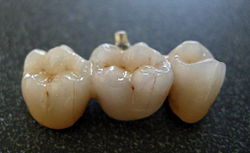Introduction and Types of Bridges
- Definitions: Fixed bridge, abutment, pontic, retainer, unit
- Advantages and disadvantages of tooth replacement
- Types of bridge: Conventional bridge, adhesive bridge, combination designs, hybrid designs
- Conventional bridge designs: Fixed-fixed bridge, cantilever bridge, fixed-movable bridge
Selection and Evaluation of Abutment Teeth
- Factors influencing abutment tooth selection
- Importance of careful abutment selection for bridgework success
- Biomechanical considerations
- Indications for use
- Contraindications
Types of Artificial Plastic Teeth
- Wash-through Pontic, Dome Pontic, Ridge Lap Pontic, Modified Ridge-Lap Pontic, Ovate Pontic
- Purpose of pontics
- Hygienic pontic, bullet pontic, ridge lap and modified ridge lap pontics, ovate pontic
Types of Bridges According to Durability and Material
- Provisional bridges: purpose, duration of use, fabrication
- Metal-based bridges: noble based metals, base metal alloys
- Non-metal based bridges: resin veneered, fibre-reinforced composite, porcelain fused to metal, ceramics
- Acrylic resin and porcelain fused to metal (PFM)
- IPs Emax ceramics
- Zirconia
Clinical Stages of Bridgework, Advantages and Failures
- Clinical stages of bridgework
- Restoration fabrication
- Advantages of bridges
- Common reasons for bridge failures
- Causes of bridge failures
- Oral manifestations of bridge failures
- Bridge failure management
- Aesthetic failures of bridges
- Related topics: dental implant, dental restoration, fixed prosthodontics, resin retained bridge
A bridge is a fixed dental restoration (a fixed dental prosthesis) used to replace one or more missing teeth by joining an artificial tooth definitively to adjacent teeth or dental implants.
| Bridge (dentistry) | |
|---|---|
| ICD-9-CM | 23.42-23.43 |
| MeSH | D003829 |



